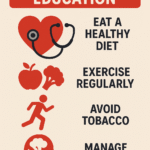
Predict Diabetic Retinopathy Risk With AI Solutions
Diabetic Retinopathy Prediction: A Vital Trend
Why It Matters Today
Diabetic retinopathy is a dangerous condition for many patients that affects millions of people worldwide. AI-driven prediction plays a significant role in this area because of the following:
- Early detection skills enable the prevention of blindness.
- AI evaluates images and treatment plans more than humans so that moves will not lead to significant faults.
- Healthcare services are not only improved but are also cost-saving
Relevance for Stakeholders
For patients, the awareness of the risks is a good way to promote proactive Care.
For researchers, AI creates unexplored research fields.
For healthcare providers, assessment systems are better and more quickly connected to patient safety.
To conclude, using AI to predict diabetic retinopathy is tech-savvy and a future technology.
Historical Context of Diabetic Retinopathy Prediction
Diabetic retinopathy, a severe eye condition, has changed considerably in the health sector. Understanding the history and economy of the disease is essential.
Evolution of the Healthcare Sector
- From recognizing the problem to taking action, An increasing number of patients with diabetes motivated healthcare facilities to consider eye care establishment as a priority.
- Artificial intelligence stands out as a key factor in diagnosing a paradigm shift.: SA technology advances quickly, and realizing such magnitude remains a miracle.
Impact on Medicine, Technology, and Public Health
- The transformation of prediction: AI can forecast risks quicker and more precisely.
- Preventative vision care: Unfortunately, some people lose their lives because of the late prevention of diseases.
- Empowering patients: Informed choices lead to better outcomes.
- Incorporating AI into diagnosing diabetic retinopathy is not just a fad; it is a groundbreaking innovation that can shape the future of eye health.
Current Landscape of Diabetic Retinopathy Prediction
AI Innovations Leading the Charge
Diabetic retinopathy is a significant cause of blindness, but AI reverses the story. Thanks to cutting-edge technology, healthcare specialists can assess the overall risk with high precision.
- More than 30% of diabetics are at risk for retinopathy.
- AI fast-tracks diagnosis by as much as 80 per cent.
Why It Matters
- Prevention is power: Early detection can save sight and reduce healthcare costs.
- Accessibility: The location of the patients doesn’t matter whether more patients can get timely screenings.
- If we effectively exploit AI’s benefits, we will follow the trend and contribute to a life-changing transformation in the healthcare sector.
The Impact of Diabetic Retinopathy Prediction on Healthcare
Transforming Patient Experience
Visualize the scenario in which predicting diabetic retinopathy is as easy as taking a quick scan. Do not be fooled by it — AI is no longer a mere daydream; it is a realized vision.
- Early Detection: Catching eye problems early on before they become severe.
- Preventative Care: By reducing the risk of blindness.
- Empowered Families: Families can decide about their health together.
Quality of Life Improvements
The application of AI in grading eye complications caused by diabetes is more than great technology for companies; it is about making the lives of individuals substantially better:
- Patients get more precise about their diagnosis and medications to control.
- They could participate more in activities when they are no longer concerned about poor eyesight.
- Testimonial: “I was told my risk of getting sick so early on, which changed things for me.”
- Moreover, the healthcare field that uses technology to treat evolving diseases must understand that technology isn’t the same old remedy; it is a lifeline now.
Impact on Healthcare Professionals
Challenges in Implementation
Adopting AI in diabetic retinopathy prediction is the most significant feat and challenge that health professionals and organizations must solve. They are:
- Training Needs: New tech that necessitates special training to adapt.
- High Costs: Deployment dilutes funds from other sectors, straining budgets.
- Integration Issues: Old systems may not only be incompatible but also may not function smoothly.
Opportunities for Growth
While the AI system does bring about some minor problems, the AI technology itself provides substantial growth chances, which can help solve the identified issues:
- Enhanced Resource Management: AI can automate time-consuming tasks, cutting expenses, improving data quality and compliance, and allowing users to complete tasks very quickly.
- Improved Patient Care: The early risk situation can be diagnosed and treated before it advances.
- We need AI to remain relevant in the world of new and improved health care that engulfs us. Therefore, it can be beneficial and more than necessary.
The Advantages of AI in Diabetic Retinopathy Prediction
Why It Matters
In this era of digital healthcare, a new paradigm arises: artificial intelligence is used to diagnose diagnostic retinopathy. Effective data use would result in the most special outcomes for the healthcare system and the patients.
Key Benefits
- Early Detection: Artificial intelligence algorithms (AIAs) are used to observe the image of the human retina and detect the presence of medical conditions before the onset of symptoms. This kind of managing conditions proactively enables patients to keep their vision.
- Streamlined Processes: Automated assessments shorten waiting times, reducing the number of errors made by the staff. Imagine speeded-up, easier medical scanning!
- Cost-Effective Solutions: Less frequent examinations with specialists are due to the increased use of AI in medicine, which reduces healthcare costs and maintains quality.
- The data shows> that the use of AI can provide 90% more accuracy in diagnosis.
- To sum up, turning to AI to predict diabetic retinopathy isn’t solely an innovation; it is imperative for the bright future of the health domain.
Challenges and Ethical Concerns in Diabetic Retinopathy Prediction
Patient Perspectives
- Data Privacy Issues: Patients may be anxious about who uses their personal information, especially in cases where health details are the subjects
- Informed Consent: Are patients misinformed about how AI utilizes their data?
- Overreliance on Technology: One-to-one interviews are on the other side of the disagreement; they foresee that AI computation might not include some private scenarios.
Researcher Perspectives
- Algorithm Bias: If the AI tools are not varied, the results may be biased, causing healthcare inequalities.
- AI Transparency: AI technologists and cognitive scientists struggle to make complex and understandable algorithms algorithms.
- Data Limitations: Reliable predictions across patients can not be made if the datasets are not very diverse.
Regulator Perspectives
- Regulatory Oversight: Venturing into realms that the currently effective laws do not govern may be possible.
- Accountability Issues: It is often difficult to ascertain whose fault is when a machine makes wrong decisions in patient care.
- Ethical Deployment: Debates about equal AI technology should continue, although they are hard to determine.
- Knowing about these constraints is an essential step in ensuring that the technology will work best for all patients and ensuring fair play.
Enhancing_Diabetic_Retinopathy_Awareness_with_AI
Embrace Technology to Protect Your Vision
Nowadays, one of life’s most valuable aspects is having good eyesight. With these Actionable pieces, here are the ways you can practice the AI technologies that predict diabetic retinopathy:
- Utilize mobile apps meant explicitly for tracking eye health. Updated apps can inform you of the latest developments.
- You can schedule virtual consultations with doctors over the Internet. Thus, staying connected with doctors and getting their recommendations is easy.
- Participate in online forums to gain insights. Such forums are good for making friends.
- Tell them that there is something wrong. Your vision is what should mean everything to you.
Future of Diabetic Retinopathy Prediction
Emerging Innovations
After a series of operations, diabetic retinopathy prediction is considered a revolutionary step in the healthcare industry. Thanks to AI and other innovative technologies, accurate and personalized medical advice will be shared with the patients.
- AI algorithms enable clinicians to detect symptoms earlier than previously possible.
- Real-Time Monitoring: Wearable tech gathers data and sends it instantly to doctors.
Career Opportunities
The research conducted in the biotechnology field will lead to the emergence of more jobs.
- Data Scientists: Craft the most potent health data analytics.
- AI Ethicists: Guaranteeing high ethical standards in technology in medical facilities.
- These innovations give hope to diabetic patients by helping them avoid vision loss at an early stage.
Key Insights for Today’s Healthcare Landscape
The Role of AI in Diabetic Retinopathy Prediction
- Stay informed: AI is the new approach for a rigorous risk assessment of diabetic retinopathy.
- Prevent Blindness: It has been proven that early detection is the only way to gain the upper hand; thus, AI technology can be beneficial here.
- Why engage? Because your eyesight counts.
- Consult your doctor for AI-based eye risk appraisals.
- Discover more about the preventive strategies available today.
- “However, embrace the future; the disease of the eye is insidious, but take care not to be arrested” is the message from this verse!












Post Comment